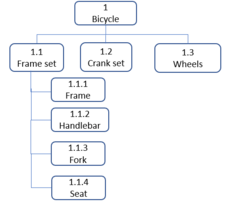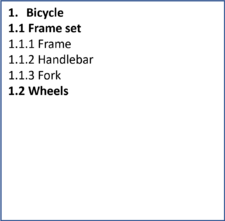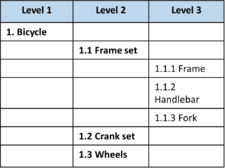Building Effective Work Breakdown Structures (WBS)
"If you fail to plan, you are planning to fail" Benjamin Franklin
Regardless of the life cycle approach, successful project management requires a comprehensive and detailed plan [1]. A project manager’s main responsibilities include planning, integrating, and executing plans. Structured planning is essential given the relatively short duration and controlled resources of projects. Without proper planning, projects, and programs can face the following consequences [2]:
- No clear and defined requirements at the beginning of the project
- Setting unrealistic expectations
- Disorder and chaos
- Attempts to place blame
- Punishment
There are four main reasons for project planning: 1) To minimize or eradicate uncertainty, 2) To improve operational efficiency, 3) To gain a better understanding of the objectives, and 4) To establish the foundation for monitoring [2]. The first major step in the planning process after defining the project requirements is to develop the Work Breakdown Structure (WBS), it is the most important element because provides a common framework for [2]:
- Describing the total project described as a summation of decomposed elements
- Planning can be performed
- Determining costs and budgets
- Monitoring time, cost, and performance
- Establishing schedules
Given all the benefits of building an effective WBS, the purpose of this article is to serve as a guide for project managers in:
- Understanding the purpose and importance of creating a WBS.
- Identifying the key characteristics and components of a WBS.
- Implementing a delivered-oriented WBS effectively.
- Evaluating the quality and completeness of a WBS.
Developed by Luisa Fernanda Salazar Rivera s222401
Contents |
1 Introduction
To determine when the development of a WBS can start, it is necessary to have an idea of the typical phases involved when launching a project [2]. Figure 1 presents a standard project launch process:

The PMBOK Guide - Seventh Edition addresses the five elements related to scope:
- Scope: Scope encompasses all the deliverables required as part of a project. A deliverable is any unique product or work that should be produced to complete a process, phase, or project. [1] [2].
- Project Scope:Refers to the tasks that must be completed to achieve the defined scope of the project [1] [2].
- Scope Statement:Document that describes the objectives, deliverables, end result, and justification of the project. It addresses the questions: who, what, when, why, where, how, and how many. This document confirms that the scope of the project aligns with the Statement of Work (SOW) provided by the customer [1] [2].
- Scope Management Plan:Document that describes how the project scope will be defined, developed, monitored, controlled, and verified. [1] [2].
- Statement of Work (SOW):document that provides information related to the customer´s requirements and expectations for the project [1] [2].
Having an understanding of key elements related to scope will enhance the reader´s comprehension of the following sections focused on detailed planning.
2 Overview of the WBS
2.1 What is a WBS
A WBS, as defined in the PMBOK Guide - Seventh Edition, is “A deliverable-oriented hierarchical decomposition of the total scope of work to be carried out by the project team to accomplish the project objectives and create the required deliverables.” [1].
2.2 Core characteristics
Based on the definition of a WBS provided in section 2.1 the following characteristics should be highlighted:
- The deliverable orientation indicates the definition of specific outcomes of the project. [1].
- The hierarchical representation indicates that a WBS is organized into parent-child relationships. Each descending level represents an increasingly detailed definition of the work [1] [3].
- The decomposition nature indicates that a WBS translates the entire project scope into smaller components called work packages as will be further described in section 3.2 [1] [3].The 100% rule is related to this core characteristic of the WBS. This rule states that the WBS should contain 100% of the work defined in the project scope and include all the required deliverables that should be completed. This rule is applicable to all levels within the hierarchy in terms of having 100% of the activities defined at the “child” level to deliver the work presented by the “parent” level [1].
2.3 Purpose of creating a WBS
The purpose of having a WBS is to assist project managers and stakeholders to develop a clear vision of the project’s outcome. It provides a visual representation of all the deliverables across the project life cycle. Additionally, the WBS assists in the planning process by defining work packages that are more manageable pieces of work that can easily be scheduled cost estimated, monitored, controlled, and communicated[1].
2.4 Why is it essential
A well-defined WBS will aid in having a commonly accepted scope definition between all project functions and stakeholders. If this is not properly aligned, the chances of having inadequate and inaccurate project deliverables are high. Furthermore, these deliverables will prevent having a good understanding with stakeholders, and a good decision-making process, and will ultimately result in not achieving the project objectives. Therefore, it is essential to align expectations and have a common understanding of the project scope among all members and stakeholders [1] [4].
3 Types and components of a WBS
3.1 Styles to present a WBS
The way project managers present the WBS can vary according to the organization's needs and how the WBS will be used. There are three main representations as shown in Table 1. It should be noted that Table 1 only introduces the most common representation styles. However, it is not a comprehensive WBS [1] [5]:
- Hierarchical:This is the most common representation of a WBS. In this structure, each box connects the child to the parent element. The most common version places the project at the top level and explicitly displays the hierarchical decomposition into smaller elements [1] [5].
- Outline:In this style, the WBS is presented as a list. Each level displays an alphanumeric outline code or numbering scheme and the component[1] [5].
- Tabular:Another representation is the tabular style. The columns in the table represent the hierarchical structure and each row have an alphanumeric outline code or numbering scheme and the component as in the outline style [1] [5].
| Hierarchical | Outline | Tabular |
|---|---|---|
3.2 Types of decomposition for a WBS
There are several valid ways to structure a WBS and its decomposition in practice. Different sources identify different types of decompositions, such as deliverable-oriented, phase-oriented, and product-oriented, among others. When building a WBS it is common to use a combination of different types of decompositions [1] [5].Table 2 provides descriptions and examples to assists in practical implementation, although the WBS examples are not exhaustive.
| Type of decomposition | Description | Example | |||
|---|---|---|---|---|---|
| A | B | <td style="width:10em;">C</td> | Deliverable-oriented | Any component that supports the delivery of the final product. |
1. Book
1.1 Outline
1.1.1 Conduct research
1.1.2 Develop an outline of the content
2.2 First draft
2.5 Editing
2.6 Printing and distribution |
| Phase-oriented | Organized based on project phases. Each phase represents a stage of the project life cycle |
1. Building
1.1 Project Preparation
1.1.1 Develop project plan
1.2 Site Preparation
1.3 Construction
1.4 Project completion | |||
| Product-oriented | Organized based on the components required to deliver a final product |
1. Bicycle
1.1 Frame set
1.1.1 Frame
1.2 Crank set
1.3 Wheels |
3.3 Main components
Building effective WBS
Preparation methods
Top-down method
Bottom-up method
Decomposing the project work
How to decompose the project work?
When to stop decomposing the work?
WBS Dictionary
Steps for building an effective WBS
Evaluating the quality of a WBS
Quality Principle 1
WBS Quality Sub-Principle 1: Core Characteristics
Limitations
References
- ↑ 1.00 1.01 1.02 1.03 1.04 1.05 1.06 1.07 1.08 1.09 1.10 1.11 1.12 1.13 1.14 1.15 1.16 1.17 Project Management Institute, Inc. (PMI)., "Practice Standard for Work Breakdown Structures (3rd Ed.)", 2019
- ↑ 2.0 2.1 2.2 2.3 2.4 2.5 2.6 2.7 2.8 2.9 Kerzner, H. ., "Project Management: A Systems Approach to Planning, Scheduling, and Controlling. (7th Ed.) ", 2009
- ↑ 3.0 3.1 Norman, E; Brotherton, S; Fried, R. "Work Breakdown Structures: The Foundation for Project Management Excellence. ", 2008
- ↑ Cicala, G. "The Project Managers Guide to Microsoft Project 2019: Covers Standard, Professional, Server, Project Web App, and Office 365 Version", 2019
- ↑ 5.0 5.1 5.2 5.3 5.4 5.5 Bucktik, L."Secrets to Mastering the WBS in Real-World Projects: The Most Practical Approach to Work Breakdown Structures (WBS)! (2nd Ed.) PMI ", 2010


